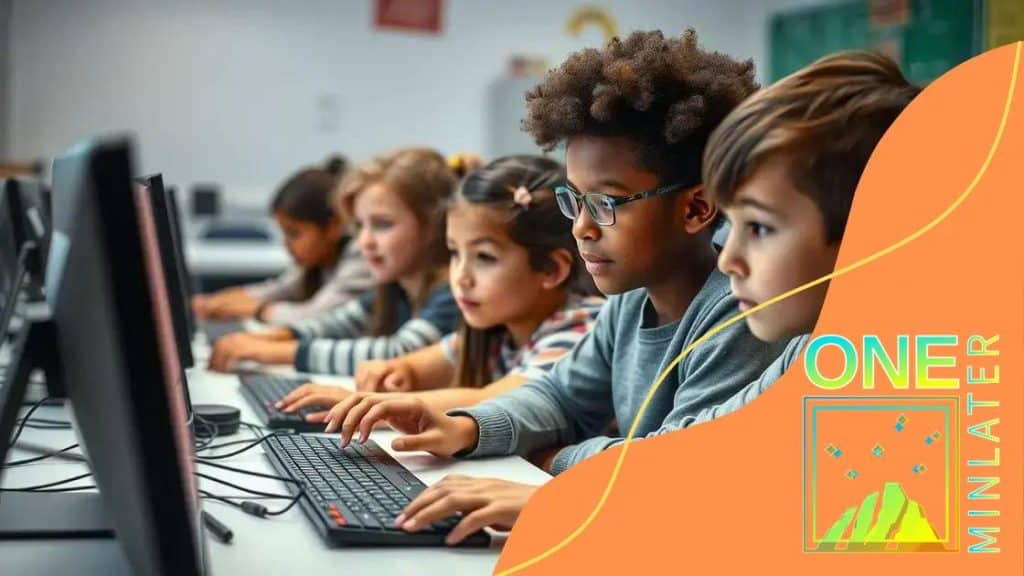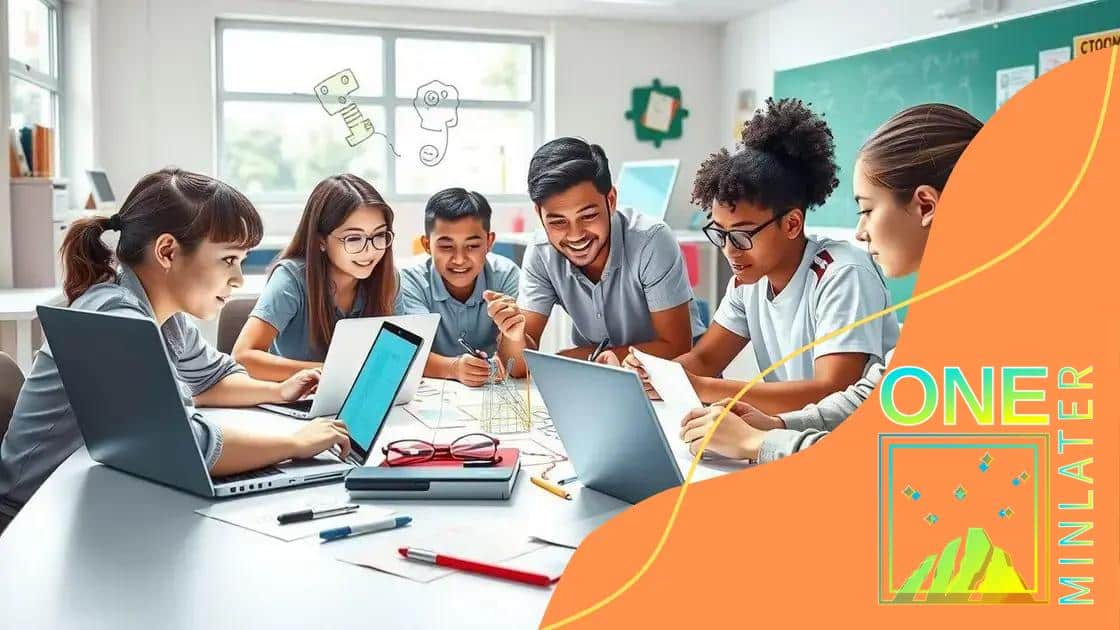The benefits of early coding education for students

The benefits of early coding education for students include enhanced problem-solving abilities, increased creativity, and better preparation for technology-driven careers through engaging resources and activities.
The benefits of early coding education for students are more significant than many might realize. It’s not just about understanding technology; it’s about preparing them for a digital future. Have you considered how coding might enhance critical thinking skills?
Why coding is essential for today’s students
Understanding the digital world is crucial for students today. Learning coding not only helps them grasp technology but also prepares them for future opportunities. Coding fosters logical thinking and creativity, essential skills in various careers.
Importance of Coding Skills
As technology evolves, coding becomes more relevant. Students who learn to code gain numerous advantages. They develop problem-solving skills that are invaluable in any field.
- Coding enhances critical thinking and logic.
- It encourages teamwork through collaborative projects.
- Coding fosters a sense of accomplishment and motivation.
Moreover, coding is not just for future software engineers. It helps students in all subjects. For instance, when students learn coding, they practice to break down complex problems into manageable parts. This skill is applicable in math, science, and even the humanities.
Career Readiness
Coding is becoming essential in the job market. Many industries now require some understanding of programming languages. Students equipped with these skills are often preferred by employers.
- Knowledge of coding opens doors to high-demand jobs.
- It provides an understanding of how digital tools work.
- Coding boosts adaptability to new technologies.
In addition, students exposed to coding early on will likely pursue careers in science, technology, engineering, and mathematics (STEM). This trend is crucial to addressing the skills gap in many industries. Having coding in their skill set enhances their marketability and prepares them for a dynamic future.
The role of problem-solving in coding education
In coding education, problem-solving skills play a vital role. These skills are important for students as they learn to break down complex tasks into smaller, manageable components. Developing problem-solving abilities helps students approach challenges logically and creatively.
How Coding Promotes Problem-Solving
When students engage with coding, they face various challenges that require them to think critically. Every time they encounter a bug or an error, it’s an opportunity to practice problem-solving. They must analyze the code, identify the issue, and come up with possible solutions. This iterative process teaches persistence and resilience.
- Students learn to analyze problems effectively.
- They practice testing different solutions until they find the right one.
- Each coding challenge strengthens their confidence in solving problems.
Moreover, through coding, students gain experience in working with algorithms. Understanding how algorithms function is key to solving problems efficiently. Students learn to structure their thinking, making it easier to create logical solutions in coding and real life.
Collaboration and Problem-Solving
Coding often involves collaboration, which further enhances problem-solving skills. When students work together on projects, they share ideas and perspectives. This teamwork encourages them to approach problems from various angles, leading to innovative solutions.
- Working in teams fosters communication skills.
- Students learn to respect differing opinions.
- Team projects promote collective problem-solving.
Ultimately, by integrating problem-solving into coding education, students not only develop crucial skills for their academic success but also prepare for future challenges they may face in their careers.
How coding fosters creativity and innovation

Coding is more than just a technical skill; it is a powerful tool for fostering creativity and innovation among students. As students learn to code, they are encouraged to think outside the box and explore new ideas. This creative process can transform their understanding of problem-solving in various contexts.
Encouraging Creative Thinking
When students engage with coding, they are faced with the opportunity to create something from scratch. This leads them to experiment and play with their ideas. As they write code, they often need to find unique solutions to challenges they encounter.
- Coding allows for experimentation with various designs.
- Students can see their ideas come to life in real-time.
- Failures and successes in coding drive creative improvement.
Through coding, learners can express their imagination by creating games, apps, and websites. As they develop these projects, they utilize a balance of creativity, logic, and technical skills. This combination also helps them appreciate the value of effort and persistence.
Innovation in Problem-Solving
Moreover, coding nurtures an innovative mindset. Students learn that problems can have multiple solutions. This mindset is crucial for approaching challenges effectively. Instead of seeing obstacles, they begin to view them as opportunities for innovation.
- Students develop a sense of ownership over their creations.
- Collaboration with peers leads to inventive solutions.
- Exposure to real-world coding challenges sparks new ideas.
Ultimately, the fusion of creativity and coding equips students with essential skills. They learn how to leverage technology to bring their ideas to life, which is invaluable in today’s fast-paced world. This process not only prepares them for future careers but also inspires lifelong learning.
Integrating coding into various subjects
Integrating coding into various subjects enriches the learning experience for students. It allows them to see the connections between technology and other fields. Whether it’s mathematics, science, or even art, coding can enhance understanding and engagement.
Coding in Mathematics
In math classes, coding offers a new way to visualize concepts. Students can create programs that help illustrate mathematical principles such as geometry or algebra. This hands-on approach makes complex ideas easier to grasp.
- Students can design simulations to understand probabilities.
- They can create visual representations of equations.
- Coding helps in solving real-world math problems interactively.
By applying coding to math, learners develop valuable analytical skills that benefit their future studies.
Coding in Science
Coding also plays a significant role in science education. Students use coding to analyze data, visualize results, and conduct experiments virtually. This method encourages them to think like scientists and fosters a deeper understanding of scientific methods.
- Students can use coding to create models of scientific phenomena.
- They learn to program simulations that mimic real-life scenarios.
- Coding aids in processing and interpreting experimental data effectively.
Through these activities, students gain a comprehensive view of how technology can drive scientific innovation.
Coding in the Arts
Even in the arts, coding has become an essential tool. It allows students to explore new forms of creativity. Through programming, they can create digital art, animations, and interactive installations that combine creativity with technology.
- Coding enables artists to push boundaries in their work.
- Students can create generative art, where algorithms drive creativity.
- This approach encourages collaboration between artists and technologists.
Combining coding with various subjects makes learning more engaging, enriching, and relevant to students’ lives. It prepares them for a world where technology and creativity intersect.
Resources for teaching coding to young learners
Teaching coding to young learners opens up a world of possibilities. Several resources are available to help educators guide students through their coding journey. From online platforms to hands-on activities, these tools engage young minds and make learning coding fun and accessible.
Online Platforms and Courses
Many online platforms offer coding courses tailored for kids. These courses usually include interactive lessons, games, and challenges. Students can learn at their own pace and explore coding concepts in an exciting way.
- Scratch: A block-based programming language ideal for beginners.
- Code.org: Offers a variety of coding games and tutorials suitable for all ages.
- Codecademy: Provides interactive programming courses for different skill levels.
By using these online resources, students can develop their skills while having fun and expressing their creativity.
Hands-On Activities
In addition to online resources, hands-on activities are a great way to teach coding. Coding games and robotics kits allow students to apply their knowledge practically. They learn coding principles and how to work in teams while building projects.
- LEGO Mindstorms: Combines coding with building robots, making learning engaging.
- Code-a-Pillar: An interactive toy that introduces younger kids to sequencing and coding fundamentals.
- Bee-Bot: A fun, floor-based robot that teaches basic coding concepts.
These activities encourage collaboration and critical thinking, essential skills in today’s world.
Books and Educational Resources
There are also many books and educational materials available for teaching coding. These resources often include step-by-step guides, project ideas, and engaging stories that make coding approachable. By incorporating these materials, teachers can provide a well-rounded learning experience.
- “Hello Ruby”: A storybook that teaches coding concepts through fun adventures.
- “Python for Kids”: An introduction to programming using Python, written specifically for young learners.
- “Coding Games in Scratch”: A guide to creating fun games using Scratch.
By utilizing these resources, educators can inspire young learners and equip them with valuable coding skills for the future. This comprehensive approach to teaching coding ensures that students not only learn the basics but also enjoy the process.
In conclusion, incorporating coding into education provides numerous benefits for young learners. It enhances problem-solving skills, fosters creativity, and prepares students for the future job market. By utilizing various resources, educators can make coding engaging and accessible to all students. As coding becomes more relevant in our technology-driven world, instilling these skills early on ensures that students are well-equipped for both academic and professional success.
FAQ – Frequently Asked Questions about Early Coding Education
Why is coding important for young learners?
Coding helps develop critical thinking and problem-solving skills while preparing students for technology-driven careers.
What resources are available for teaching coding?
There are many resources, including online platforms like Scratch and Code.org, hands-on activities, and educational books.
How does coding foster creativity in students?
Coding allows students to create digital projects, encouraging them to express their ideas and experiment with new concepts.
Can coding be integrated into other subjects?
Yes, coding can enhance subjects like math, science, and art, providing a comprehensive learning experience for students.





